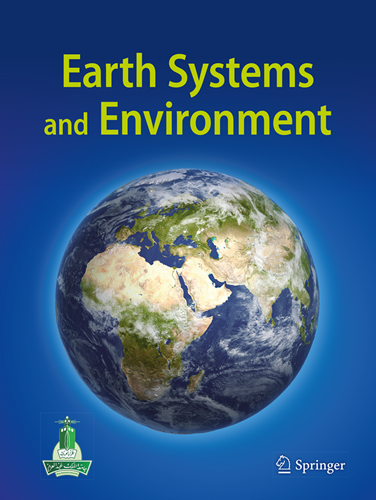基于Cordex模拟的叙利亚气候:现在和未来
IF 5.3
Q1 ENVIRONMENTAL SCIENCES
引用次数: 1
摘要
区域气候模式被广泛用于评估当前和未来气候变化的影响。在本研究中,我们评估了协调区域气候降尺度试验项目的区域气候模式在以下三个CORDEX域上的表现:AFR、MNA和WAS。在网格间距为0.44°的情况下,对叙利亚的四个气象变量(温度、降水、太阳辐射和云量)进行了评估。利用CRU、ERA5再分析和SARA和CLARA卫星资料,评价了5种模式在模拟1989-2008年当前气候特征方面的表现。我们发现微型集合很好地捕捉了所选变量的一般空间格局和年周期。本研究的另一个目的是评估上述四个气候变量在中等排放情景(RCP4.5)和高排放情景(RCP8.5)下近期(2031-2050)和远期(2080-2099)相对于当前气候(1989-2008)的预期变化。模拟显示,无论强迫情景如何,到本世纪中后期,云量(在6%至10%之间)和降水量(高达9%)都有减少的趋势。模拟结果显示,叙利亚上空明显变暖,按照高温室气体浓度情景(RCP8.5),预计到21世纪末气温将达到6°C。此外,这种增加,加上降水减少,将使叙利亚的气候变得更加干旱。本文章由计算机程序翻译,如有差异,请以英文原文为准。
Climate of Syria Based on Cordex Simulations: Present and Future
Abstract Regional climate models are widely used to assess current and future impacts of climate change. In this study, we evaluate the performance of regional climate models from the Coordinated Regional Climate Downscaling Experiment programme integrated over the following three CORDEX domains: AFR, MNA and WAS. Four meteorological variables (temperature, precipitation, solar radiation and cloud cover) were evaluated over Syria at a grid spacing of 0.44 ° . The performance of five models in simulating the present climate characteristics (1989–2008) is evaluated with respect to the observations: CRU, ERA5 reanalysis and SARA and CLARA satellite data. We find that the mini-ensemble captures well the general spatial patterns and annual cycles of the selected variables. Anotheraim of this study was to assess the expected change of the mentioned four climate variables over Syria under the moderate emission scenario (RCP4.5) and the high emission scenario (RCP8.5) in the near future (2031–2050) and in the far future (2080–2099) with respect to the present climate (1989–2008). The simulations show a decreasing trend in cloud cover (between 6% and 10%) and precipitation (up to 9%) by mid and late century, regardless of the forcing scenarios. The simulations show a pronounced warming over Syria, which is expected to reach 6 °C by the end of the twenty-first century following the high greenhouse gas concentration scenario (RCP8.5). Furthermore, such an increase, combined with a decrease in precipitation, will shift Syria’s climate towards a more arid one.
求助全文
通过发布文献求助,成功后即可免费获取论文全文。
去求助
来源期刊

Earth Systems and Environment
Multiple-
CiteScore
15.50
自引率
5.60%
发文量
50
期刊介绍:
Earth Systems and Environment(ESEV) publishes peer-reviewed original and review articles on the entire range of Earth systems and environment in order to further our understanding of the natural workings and various processes and interactions that govern the Earth systems in response to complex environmental problems caused by natural and human-induced forcings.
The journal disseminates high-quality information on cutting-edge developments in the various research fields of Earth systems and environment based on new methods, theories, and applications. It has a multidisciplinary character, focusing on interrelated scientific topics combining diverse aspects of the Earth systems and environment including:
Climate and atmospheric sciences; Earth and environment related agricultural sciences; natural hazards and engineering; marine sciences; ecology; desertification; pollution; geo-environmental hazards; droughts and floods; hydrosphere, lithosphere and troposphere dynamics; waste management; numerical models of earth systems; geographical information systems; remote sensing; and environmental health, etc.
In order to meaningfully explore these topics, researchers in the environmental Earth science disciplines are invited to contribute their original research and review articles on significant scientific advances in the form of papers, technical notes, broad reports, case studies, reviews, brief communications and discussions.
More about the journal:
Published by Springer in partnership with King Abdulaziz University (KAU).
Indexed in Web of Science ESCI and Scopus (2021 Cite Score = 6.5).
Authors of the best papers receive an award and a remuneration from KAU each year.
Papers are screening for originality and similarities before handling them by topical editors.
The journal uses double-blind review.
The first round of peer review does not exceed 30-45 days.
Mostly two/three or even four revisions are required before final acceptance.
Committed to meeting standards of ethical behavior at all stages of the publication process.
The COPE code of conduct and Springer editorial policies are used as the basis for the publication process.
Earth Systems & Environment (ESEV) is committed to upholding the integrity of the scientific record. As a member of the Committee on Publication Ethics (COPE) the journal will follow the COPE guidelines on how to deal with potential acts of misconduct. Authors should refrain from misrepresenting research results which could damage the trust in the journal and ultimately the entire scientific endeavor. Maintaining integrity of the research and its presentation can be achieved by following the rules of good scientific practice as detailed here:
https://www.springer.com/us/editorial-policies
 求助内容:
求助内容: 应助结果提醒方式:
应助结果提醒方式:


